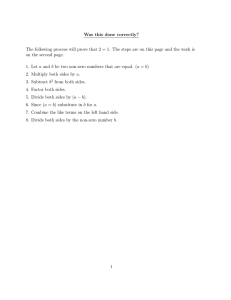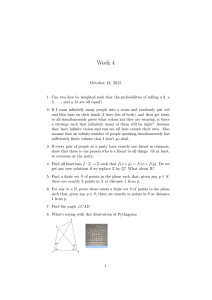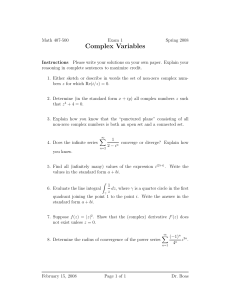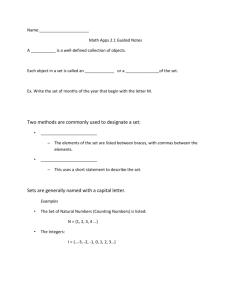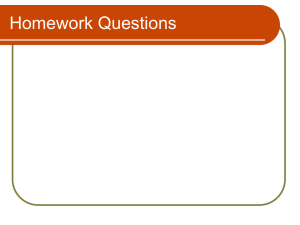Solution of EECS 316 Test 3 Su10
advertisement
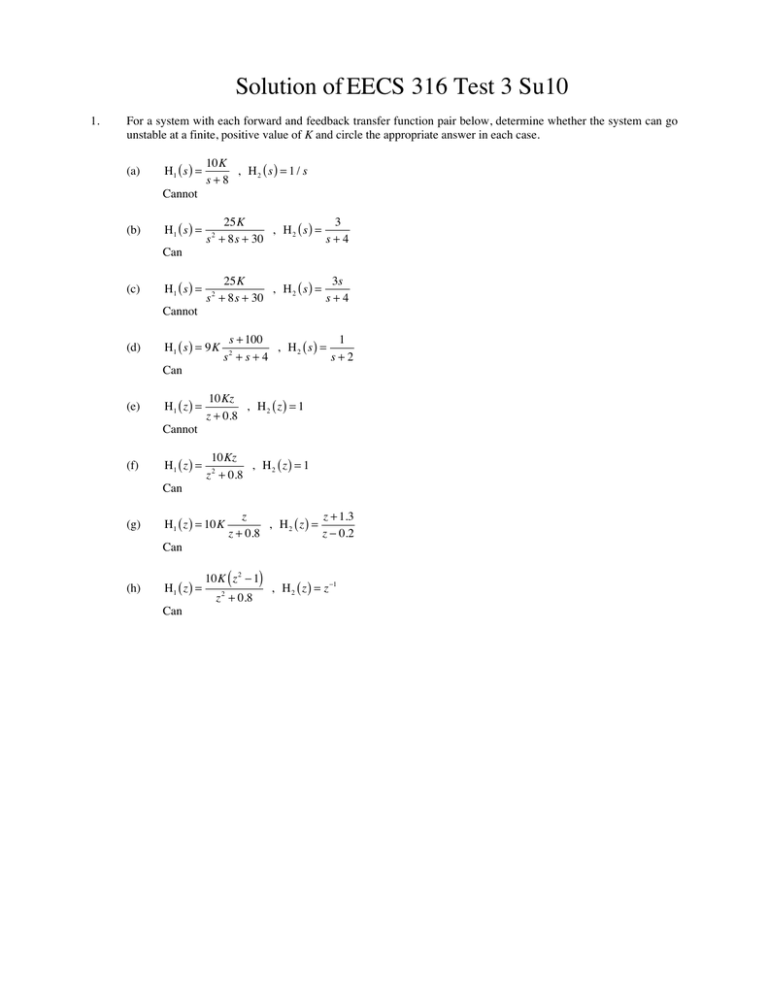
Solution of EECS 316 Test 3 Su10 1. For a system with each forward and feedback transfer function pair below, determine whether the system can go unstable at a finite, positive value of K and circle the appropriate answer in each case. (a) H1 ( s ) = 10K , H2 ( s) = 1 / s s+8 Cannot (b) H1 ( s ) = 25K 3 , H2 ( s) = s 2 + 8s + 30 s+4 Can (c) H1 ( s ) = 25K 3s , H2 ( s) = s + 8s + 30 s+4 2 Cannot (d) H1 ( s ) = 9K s + 100 1 , H2 ( s) = s2 + s + 4 s+2 Can (e) H1 ( z ) = 10Kz , H2 ( z) = 1 z + 0.8 Cannot (f) H1 ( z ) = 10Kz , H2 ( z) = 1 z 2 + 0.8 Can (g) H1 ( z ) = 10K z z + 1.3 , H2 ( z) = z + 0.8 z − 0.2 Can (h) H1 ( z ) = Can ( ) 10K z 2 − 1 z 2 + 0.8 , H 2 ( z ) = z −1 2. Using the mapping relationship z = esTs draw the region in the z plane that corresponds to the region −0.5 / Ts < σ < 0.5 / Ts , 3π / Ts < ω < 4π / Ts in the s plane. (Use the axes on the left to practice and draw the final graph on the right. Only the right-hand graph will be graded.) [z] 1 2 3. Below are some forward-path transfer functions for some unity-gain-feedback tracking systems. In each case determine whether the system is stable or unstable. If the system is stable, then determine whether the steady state error in response to a step and a ramp will be zero, non-zero finite or infinite in magnitude. If the system is unstable, just skip to the next system without addressing the steady-state error. (a) H1 ( s ) = 10 s+8 Pole at -18, Stable, Non-Zero Finite, Infinite (b) H1 ( s ) = 25 s s + 8s + 30 ( 2 ) Poles at -1.1219, -3.439 +/- j3.234, Stable (c) H1 ( s ) = 25 s 2 + 8s + 30 Poles at -4 +/- j6.245, Stable, Non-Zero Finite, Infinite (d) H1 ( s ) = 9 s + 100 s 2 + 2s Poles at -5.5 +/- j29.5, Stable, Zero, Non-Zero Finite 4. Draw a cascade realization of a system with a transfer function H ( z ) = 14 H ( z ) = 14 ( ) + + - + z <1 0.2 ) z ( z − 2) z ( z − 2) = 14 ( z + 0.2 ) ( z + 0.1) ( z − 0.8 ) z + 0.3z + 0.02 ( z − 0.8 ) 2 + X(z) + - ( z ( z − 2) . z + 0.3z + 0.02 ( z − 0.8 ) 2 ... 14 + - z <1 0.1 z <1 -2 <0.8 Y(z) Solution of EECS 316 Test 3 Su10 1. For a system with each forward and feedback transfer function pair below, determine whether the system can go unstable at a finite, positive value of K and circle the appropriate answer in each case. (a) H1 ( s ) = 25K 3 , H2 ( s) = s 2 + 8s + 30 s+4 Can (b) H1 ( s ) = 25K 3s , H2 ( s) = s + 8s + 30 s+4 2 Cannot (c) H1 ( s ) = 9K s + 100 1 , H2 ( s) = s2 + s + 4 s+2 Can (d) H1 ( z ) = 10Kz , H2 ( z) = 1 z + 0.8 Cannot (e) H1 ( z ) = 10Kz , H2 ( z) = 1 z 2 + 0.8 Can (f) H1 ( z ) = 10K z z + 1.3 , H2 ( z) = z + 0.8 z − 0.2 Can (g) H1 ( z ) = ( ) 10K z 2 − 1 z 2 + 0.8 , H 2 ( z ) = z −1 Can (h) H1 ( s ) = Cannot 10K , H2 ( s) = 1 / s s+8 2. Using the mapping relationship z = esTs draw the region in the z plane that corresponds to the region −0.5 / Ts < σ < 0.5 / Ts , -4π / Ts < ω < −3π / Ts in the s plane. (Use the axes on the left to practice and draw the final graph on the right. Only the right-hand graph will be graded.) [z] 1 2 3. Below are some forward-path transfer functions for some unity-gain-feedback tracking systems. In each case determine whether the system is stable or unstable. If the system is stable, then determine whether the steady state error in response to a step and a ramp will be zero, non-zero finite or infinite in magnitude. If the system is unstable, just skip to the next system without addressing the steady-state error. (a) H1 ( s ) = 9 s + 100 s 2 + 2s Poles at -5.5 +/- j29.5, Stable, Zero, Non-Zero Finite (b) H1 ( s ) = 10 s+8 Pole at -18, Stable, Non-Zero Finite, Infinite (c) H1 ( s ) = 25 s s 2 + 8s + 30 ( ) Poles at -1.1219, -3.439 +/- 3.234, Stable (d) H1 ( s ) = 25 s + 8s + 30 2 Poles at -4 +/- j6.245, Stable, Non-Zero Finite, Infinite 4. Draw a cascade realization of a system with a transfer function H ( z ) = 11 H ( z ) = 11 ( ) + + - + z <1 0.5 ) z ( z + 2) z ( z + 2) = 11 ( z + 0.5 ) ( z + 0.2 ) ( z − 0.6 ) z + 0.7z + 0.1 ( z − 0.6 ) 2 + X(z) + - ( z ( z + 2) . z + 0.7z + 0.1 ( z − 0.6 ) 2 ... 11 + - z <1 0.2 z <1 2 -0.6 Y(z)
